Teacher’s Commentary
fall 2025
escaping egypt I god delivers us I following god with courage



escaping egypt I god delivers us I following god with courage


Custom-created videos accompany every Echoes lesson. Right before Step 2, a three-minute video introduces each unit theme. A guide, found with the videos, ties the unit theme to the day’s lesson.
Unit family devotions, along with the videos, can be sent to your families to continue learning at home.
You can stream these videos from the site or download them to your own device. Get
ECHOES
Upper Elementary Teacher’s Commentary
A self-contained teaching program for use with Upper Elementary Creative Teaching Aids and Bible Adventures
© 2025 David C Cook. Permission required to reproduce. All rights reserved. Printed in South Korea.
Echoes is a multicultural curriculum published quarterly by David C Cook, 4050 Lee Vance Drive, Colorado Springs, CO 80918, U.S.A. Visit our website at DavidCCook.org. Contact us at 1-800-323-7543 (U.S. only) In Canada visit parasource.com (Canada Only) or 1-800-263-2664 (Canada Only)
To equip the Church with Christcentered resources for making and teaching disciples who obediently transform today’s generations . . . David C Cook is a nonprofit organization dedicated to international Christian education.
Editor: Rebecca Stone
Designer: Dale Johnson
Cover Photography © Klaus Vedfelt/Getty Images
All Scripture quotations, unless otherwise indicated, are taken from the Holy Bible, New International Version TM, NIV TM Copyright © 1973, 1978, 1984, 2011 by Biblica, Inc. Used with permission. All rights reserved worldwide. www. biblica.com.

BY DAVID C COOK
Unit 13
Escaping Egypt
These lessons on Moses show how he learned to rely on God’s help to bring God’s people out of Egypt. As students see Moses’ perseverance and dependence on God, they will be encouraged to trust God’s help for their own lives.
Unit 14
God Delivers Us
In these lessons about Moses and the Israelites journeying to the Promised Land, preteens will see how God remained with them through their hopeless situations and wrong choices. Students will find that God also desires to stay by their side through all their ups and downs.
Unit 15
Following God with Courage
These lessons about Joshua turning to God to help him lead shows students that trusting God takes courage. As students see Joshua’s example, they will be challenged to choose courage as they walk with God.

A few thoughts as you teach this quarter …
Where is God asking you to step out in faith?
Moses took many steps of faith when God sent Him to deliver His people from their bondage in Egypt. Moses had a lot of excuses at first, but he persevered and completed the work God gave him.
Think about this: What excuses are holding you back from doing what God is calling you to do? This quarter’s lessons about trusting God’s plan and will for our lives should challenge us to take that bold step of faith we’ve been putting off.
As you teach your students this quarter, encourage them to ask God for the strength to do what He is calling them to do, then tell them to “be strong and courageous. Do not be afraid; do not be discouraged, for the Lord your God will be with you wherever you go” (Joshua 1:9).
It only takes a couple minutes … teacher training articles and videos are online! Visit http://EchoesCurriculum.com/training

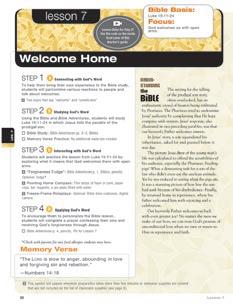

Each teacher commentary contains step-by-step instructions for sharing the lesson with your students. Bible study lessons, exciting activities, relevant cultural content, and teacher helps combine for easyto-teach lessons for fourth and fifth graders. One per class.

PraisePAC features four songs that correlate with each of the three units per quarter along with a booklet containing lead (song) sheets and lyric sheets. Both full and accompaniment versions are available for each song.




Visual and audio resources (such as posters, games, stand-up figures and PraisePAC) enhance the lessons in the teacher’s commentary. One per class.



This student book, with four pages for each lesson, includes Bible Study pages and activities. The cover includes the quarter’s memory verses and a poster or activity. Need one per student.



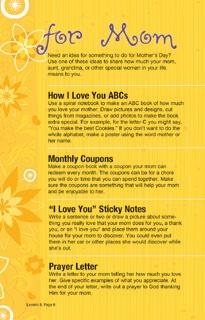

Pix
Send home these weekly eight-page booklets to reinforce lessons with excerpts from The Action Bible. Pix includes stories, crafts and more as well as Faith Forward—lesson-related devotions for preteens and their families. While Pix is not distinctly Echoes, it is an outstanding resource for families. Need one per student.


Each unit features a different video showing children living out their faith in everyday life. These three-to-fourminute video segments highlight the monthly unit theme.
There are two downloadable guides to help bring the videos into the lives of your students:
Video Connection Guide: These tie-ins can be used at the beginning of the Step 2 Bible Study. Each lesson has a tie-in that connects the theme of the video to the day’s Bible study or lesson focus.
Family Devotions Guide and the lesson videos it connects with are available for the families in your church. Email the guides to families or download them and print them for each unit. Families can use the devotion on its own or also stream that unit’s lesson video to help their family learn and grow together. These devotions are a great way for families to build faith in everyday life!
Videos, video guides, and family devotions guides can be found at EchoesCurriculum.com/ video

The Upper Elementary Teacher’s Commentary, Upper Elementary Creative Teaching Aids, Bible Adventures, and Pix are also available in a digital format. Need one bundle per class.


FREE! Downloadable Options for Steps 1 and 4
» Relevant subjects (pop culture, trending topics, and fascinating events) that are going on in your students’ world today will help them recognize how God’s Word relates to them here and now.
Superintendent’s Handbook has multi-grade material, on a common Biblical theme, to open and close the Sunday school hour. that today to and
» Cover topics that students hear and talk about all the time but rarely discuss in Sunday school! RealLifeDownloaded.com
Find ways to spark your heart and ignite your children’s ministry. Go to MinistrySpark.com and sign up to receive more free resources.
o Upper Elementary Teacher’s Commentary (1 per class)
o Upper Elementary Creative Teaching Aids (1 per class)
o Bible Adventures (1 per student)
o Pix (1 per student)
o Bibles
o Clear tape, masking tape
o Colored pencils
o Construction paper, scrap paper
o Crayons and colored markers
o Glue or glue sticks
o Media player
o Notebooks for Prayer journals (1 per student)
o Pens or pencils
o Poster board
o Scissors
o Whiteboard, markers, and erasers
See individual lessons for additional supplies needed.

Echoes step-by-step format allows students to learn Bible truths and how to apply them to their lives. With extra information for teachers, and detailed activities and lessons, students leave class with a deeper understanding about God’s Word.
Teacher Pages give you an overview of the lesson while helping you prepare for what you will teach.
Life Need includes an activity and discussion to help children connect with each other and with God’s Word through their individual ideas and experiences. This step motivates and gets preteens thinking about the Bible truth. For an option that uses current topics and issues for this step, go to RealLifeDownloaded.com.
Bible Learning gives preteens an opportunity to hear and study what the Bible says about the Bible truth. This section also includes a Bible review to check briefly for basic understanding.
Bible Application allows students a time to explore and interact with the concepts they’re learning. They discover how the Bible truth and lesson aim applies to their lives.
Life Response gives students time to create a personal response to what they have learned in God’s Word. They decide how to apply the Bible Truth to everyday life. If you used Real Life Downloaded in Step 1, use the correlating Step 4 here.

By Juliet Liu
Among the many who played a role in the civil rights movement of the mid-twentieth century, Ella Baker stands out as a unique representation of leadership. Ella Baker shows the meaning of Christlike leadership—not seeking to be a charismatic person in the spotlight but accepting the role of a quiet servant, one who raises others up. She demonstrates that true leadership is rooted in giving and empowering others.
Born in 1903 in the state of Virginia, Ella Baker grew up in a family that valued education and community activism. Her grandmother was born into slavery, and her parents instilled in her a strong sense of justice and the importance of standing up against inequality. After college, she began a career as a teacher. Soon her passion for activism took center stage in her professional and personal life. This activism was rooted in the stories her grandmother told, about what it was like to grow up enslaved.
Activism and the NAACP
Baker demonstrated her commitment to civil rights in the 1930s when she began working with the National Association for the Advancement of Colored People (NAACP). Beginning as a volunteer, her hard work and determination advanced her to several leadership roles. Throughout the 1940s, Baker acted as the organization’s first field secretary.
Baker believed in the power of ordinary people to effect change, and her role only made her more certain. This belief would shape her approach to leadership throughout her life, as she began to witness that real power lies in collective action, not in the visibility of individuals.
SCLC and the Importance of Collective Action
In 1957, Baker founded the Southern Christian Leadership Conference (SCLC) alongside Dr. Martin Luther King Jr. and others. As she worked with Dr. King, Baker began to see her vision of leadership diverge from many male counterparts in the SCLC. Several of these men emphasized a centralized, charismatic leadership model: they believed only strong leadership would drive the civil rights movement forward. But Baker advocated for the opposite—a more decentralized, democratic approach to organization. She believed that leadership should not just arise from public speakers in the limelight but from ordinary members of the community. For Baker, it was essential to nurture the skills and voices of those who might otherwise remain unheard.
SNCC and the Empowerment of Young Leaders
Baker’s commitment to empowering others became especially evident in her approach to youth activism. She understood the necessity to engage young people in the civil rights movement and recognize their capacity to drive change. While the SCLC and the NAACP had always made efforts to convince young activists to join their existing organizational structure, Baker feared that young students would not be taken seriously or allowed to contribute in their own unique ways. Baker encouraged the college students to create their own movement. Thus Baker inspired

a generation of young men and women to an active rather than passive role in the struggle for civil rights.
A Quiet Leader
Behind closed doors, Baker challenged Dr. King. She argued that, if people were tempted to worship and follow him as an extraordinary hero, this would not be good for the movement. An emphasis on other charismatic leaders might cause ordinary citizens to question their own ability to make meaningful contributions. Ella Baker did not back down from conflict, and she continued to grow the movement in her own ways.
Baker famously stated, “Strong people don’t need strong leaders.” This philosophy emphasizes the importance of empowering individuals to take ownership of their activism. It is all too easy to tell ourselves, Someone else can be the one to do it. But Baker encouraged individuals to think critically and to take action; she fostered that sense of agency.
Defined by humility and a focus on service rather than personal acclaim, Baker’s leadership style was effective. As she worked behind the scenes, provided support and guidance to others—while deliberately avoiding the spotlight for herself—Baker modeled a different path. Her mentorship extended beyond mere guidance; she invested in the growth, contributions, and success of all those around her.
Ella Baker’s life reminds others of the leadership style of Jesus, who told His disciples that anyone wishing to be a leader must first be a servant of others (Mark 10:43–45). She embodied this principle, demonstrating that true leadership is not about seeking power or recognition but about lifting others up and serving the community. Baker’s legacy lives on and continues to influence activists and leaders today, especially those who value collaboration and community engagement. In a world that values charisma and personal glory, Baker’s example says, Think again. She teaches that effective leaders emerge from the community, driven by a passion for justice and a commitment to the good of others.
Unit 13 Theme:
Escaping Egypt
Church/Home Theme: God Redeems and Restores Us
Life Need (5–10 minutes)
• Take a test to learn about following directions.
◽ Copies of “Pop Quiz” Teaching Aid, pens or pencils
Bible Learning (15–20 minutes)
• Talk about God’s plans for His people.
□ “God’s Master Plan of Salvation/God Sets His People Free” Teaching Aid
• Bible Study: Discuss how Moses tried to free the Hebrews from slavery by using his own methods.
□ Bible Adventures pp. 2-3, Bibles
• Bible Review: Discuss the promises of God and the need to follow His ways.
□ “The Long March Home” and “Bible Map Figures” Teaching Aids, glue stick or tape, Bible Adventures p. 1, pencils
Bible Application (5–10 minutes)
• Memory Work: Use Scripture to determine which way is God’s way.
□ Bible Adventures p. 4, Bibles, pencils
➲ Life Response (about 5 minutes)
• Plan ways to follow God’s directions in the coming week.
□ Copies of “Pop Quiz” Teaching Aid used in Step 1, Bibles, pencils, markers
“My thoughts are not your thoughts, neither are your ways my ways,” declares the L ord
—Isaiah 55:8
◽ indicates items you will need to prepare before class
Bible Basis:
Lesson Video for Step 2! Check out the contents page for details.
Moses tries to do God’s work by his own faulty methods and fails (Exodus 1:7—2:15).
Bible Truth:
God’s ways of doing things are not always our ways.
Lesson Aim:
That your students will discover how to learn God’s ways for getting things done.
This week begins a new quarter in which we’ll see how God led the Israelites from slavery in Egypt to conquest in the promised land.
The first unit shows how God was with His people, even when they were locked in combat with opposing forces.
The second unit of the quarter focuses on how God cared for His people as He led them to the promised land. The final unit examines some of the ways God helped the Israelites possess the land He promised them.
Now 350 years had passed since Joseph brought his father’s family to Egypt. By this time, a pharaoh who did not remember Joseph, or what he had done for Egypt, had come to power.
Because he was afraid of the Hebrews, the pharaoh enslaved them and used them to build his great cities. Many Hebrews served as bricklayers in Pharaoh’s building program.
God knew the anguish of His people and was about to raise up a leader—Moses—to lead them back to the land He had promised them.
The Jewish historian, Josephus, says that an Egyptian seer (prophet) told the king that a child was about to rise among the Hebrews who would crush Egypt’s power and raise his own



Understanding the BibLe —cont'd.
nation to power. To avoid this threatening possibility, Pharaoh ordered the deaths of male Hebrew babies (Ex. 1:22).
But God’s ways are higher than man’s, so the baby Moses was spared and rescued from the Nile by one of Pharaoh’s daughters. As the adopted son of the princess, Moses received the education of an Egyptian prince.
In defending a Hebrew slave, as related in this week’s lesson, Moses took great personal risk. He killed an Egyptian. As a result, he became Pharaoh’s enemy and had to leave Egypt.
Moses learned a lesson the hard way. We can apply the same lesson to our lives: when God calls us to do something, it’s best to wait for God’s leading and God’s timing.

How can you promote knowledge of God’s Word and God’s ways?
• Ask lots of questions to encourage discussion among your students and to find out their opinions. For example: Do you think Miriam lost faith in God as she saw what was happening to her younger brother? Would you have hidden your action like Moses did? Did Moses repent of his wrong actions? How would you feel in such a situation? Asking questions such as these can help you find out if your students are paying attention.
• Encourage students to read God’s Word daily. Remind your students that reading the Bible helps them learn about God.
• Introduce students to Bible dictionaries and Bible concordances to help them look up verses or terms they find difficult to understand.
Your upper-elementary students are trying to “spread their wings.” They are increasingly independent in their thinking and actions. Some think that they know it all, although their judgment may not show a lot of maturity. Others are indecisive strugglers trying hard to figure out answers on their own. Still others are earnestly searching for God’s plan for them.
Choose from the following activities to do as students arrive.
■ Bring in a street map of your city. Have students write out GPS style directions from their home to another place, such as your church. Students may wish to exchange their directions to see if others can follow them
□ map, paper, pencils
■ On 3-by-5-inch note cards, write out the steps needed for baking a pie—one step on each card. Throw in a few steps that don’t belong. Using masking tape, put the cards in random order on the wall. Allow students to try to get the steps in the proper order.
□ index cards, masking tape
■ For Worship Time: Use the songs for this quarter on the PraisePAC audio files from the Upper-Elementary Creative Teaching Aids packet. The PraisePAC includes audio files as well as lyric sheets and song sheets.
□ PraisePAC audio files, media player
These students are increasingly facing peer pressure. As their teacher, you can bring the needed balance to your students through this lesson by showing them God’s ways for getting things done. You have the opportunity to help them with what they need to grow as Christians—a steadfast obedience to doing things God’s way, according to His plan.
Life Need
(5–10 minutes)
That your students will discover how to learn God’s ways for getting things done.

Objective: That your students will think about what we need directions for and what happens when we don't follow directions.
Materials:
□ Copies of “Pop Quiz!” Teaching Aid
□ pens or pencils
Start your class with a lighthearted, mock quiz to show them the importance of following directions. It’s okay to create a tiny bit of test anxiety as you hand out the papers.
We’re off to a new school year, so let’s see how well you can follow directions. Don’t worry, this won’t be graded! But please do your very best. You will only have three minutes to complete this quiz!
Give each student a copy of “Pop Quiz” from Upper Elementary Teaching Aids and a pencil or pen. Tell students they may begin. Announce the time remaining at oneminute intervals, if students are still working. Then, when the time is up, have students gather together for a discussion.
Discuss:
➲ Have you ever taken a quiz like this before? Tell us a little about that.
➲ Who didn’t follow directions?
➲ What did you do wrong? (Rushed through the quiz.)
➲ Who did follow directions?
➲ What did you do right? (Read carefully, acted thoughtfully.)
➲ What thoughts do you sometimes have that might hinder you from following directions? (We think we know it all. Allow students to give their answers.)
➲ What do we sometimes do that leads us away from following directions? (We don’t pay attention, we don’t read carefully.)
➲ How are directions important in our everyday lives? (They guide us, keep us from harm.)
➲ Who usually gives you directions? (Teachers, doctors, parents, grandparents, etc.)
D OWNLOADED
Free! Downloadable Options for Steps 1 and 4.
➲ What kinds of things do we need directions for? (How to do homework; how much medicine to take and when to take it; how to get somewhere that we’ve never been; how to make a great sweet potato pie.)
➲ What are some of the things that might happen if we don’t follow directions? (People might get more sick from taking medicine incorrectly; pie might burn or undercook; we might get a bad grade on an assignment; or you could have a perfect assignment, but the teacher doesn’t know it’s yours because your name isn’t on it.)
Today’s Bible topic is all about doing things God’s way, not our way. In other words, we are to follow God’s directions for us, both in how we think, and in how we act. Today’s lesson tells us some of the story of Moses. Moses was a great leader of the Israelites, but that doesn’t mean he always followed God’s directions. Let’s find out what happened when Moses thought he could make decisions without first asking what God wanted him to do.
Bible Learning (15–20 minutes)
Bible Basis:
Moses tries to do God’s work by his own faulty methods and fails (Exodus 1:7—2:15).
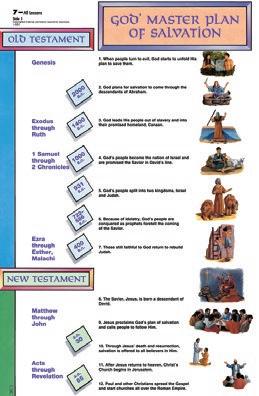

Objective: That your students will discuss what Moses learned after he tried doing God’s work his own way.
Materials:
□ “God’s Master Plan of Salvation/God Sets His People Free” Teaching Aid
□ Bible Adventures pp. 2-3, Bibles, pencils
□ “The Long March Home” and “Bible Map Figures” Teaching Aids
□ glue stick or tape
Before beginning the Bible study, use the “God’s Master Plan of Salvation” Teaching Aid to help students gain an overview of the Bible. Read statement 2 on Side 1 and then flip it over to Side 2, “God Sets His People Free.” Read the first statement on this side. What can you tell me about Joseph? Students may recall that Joseph had been sold into slavery by his brothers and taken to Egypt. After a period of suffering and imprisonment, he became a respected leader in Egypt. He was second in command under the ruling pharaoh. At the end of the Book of Genesis, Joseph was reunited with his brothers. All of Joseph’s family, 70 in all, moved to Egypt and settled under the ruling pharaoh’s favor. As the book of Exodus begins, hundreds of years have passed. Joseph’s family, now a large nation of people, is enslaved under Pharaoh, the ruler of Egypt.
Give students a copy of Lesson 1 Bible Adventures. Explain the features in the study pages, including footnotes that help with word pronunciation and give additional facts. Have students open to pages 2 and 3 and read the introduction to themselves. Ask students to look up Exodus 1:15-17, then choose a volunteer to read the passage.

➲ What did Pharaoh order the midwives to do? (Kill the Hebrew boys when they were born.)
➲ Why didn’t Shiphrah and Puah obey Pharaoh? (Because they feared God.)
Ask a volunteer to read the first section of Scripture Spotlight (Ex. 1:22; 2:1-3) from Bible Adventures. Read statement 2 on “God Sets His People Free.”
➲ Was it right for the midwives and the mother to disobey Pharaoh? Why? (Yes, because we need to obey God’s directions above all others. God’s directions will not lead us down a wrong path. God is always right.)
Ask another volunteer to read the second section of Scripture Spotlight (Ex. 2:11-14).
➲ What did Moses do to the Egyptian who was beating the Hebrew? (Killed him and hid his body in the sand.)
➲ What did Moses do the next day? (Tried to stop two Hebrews from fighting.)
➲ Who was Moses trusting in? Why? (Himself, because he didn’t know God’s directions. Sometimes we act without thinking, or we think it’s easier to do things our own way.)




Ask a student to read the concluding paragraph. Sometimes, we want to run away and avoid the consequences of our actions. This is what Moses did when he ran away to Midian.
We can see that rescuing the Hebrews was a big job! Moses was not quite ready for it. Let’s take a look at where Moses started out in the story and where he ended up.
Display “The Long March Home” Teaching Aid. Use this two-sided map this quarter to help students keep track of the progress of God’s people as they travel to the promised land. The “Bible Map Figures” Teaching Aid has figures that represent events that took place throughout this quarter’s lessons. Trace Moses’ flight to Midian on the map.
Have a student place Figure 1A (brick) in the area around Rameses. Have another student place Figure 1B on the Nile River near Goshen. Baby Moses’ basket floated him to safety along the Nile River, according to God’s plan.
➲ Do you think that when Moses grew up, he or the other Hebrew people understood what was happening to them?
(Let students respond.)
Have students turn to Bible Adventures page 1. The Hebrews had to look back at God’s promises to keep serving while waiting for God to save them. Let's look at those Scriptures. Ask three volunteers to read Genesis 15:13-15; 17:8; 35:11.
➲ What does Genesis 15:13-15 promise? (God said that Abraham’s descendants would be enslaved and mistreated for 400 years. God, however, promised He would punish the Egyptians and bring the Hebrews out of bondage with great possessions.)
Though the Hebrews were slaves in Egypt, Genesis 17:8 promised them that God had a way of providing a homeland.
➲ What was the promise? (God promised the Hebrews the land of Canaan.)
➲ To whom did God promise this? (See verse 9: Abraham.)
Although the Hebrews seemed powerless and were ruled over by the Egyptian pharaoh, God made another promise to Abraham’s grandson Jacob.
➲ What did God promise Jacob in Genesis 35:11? (God promised that the Hebrews would become a nation and kings would come from their line.)
Check the correct boxes on the checklist on this page based upon what you believe God expected of His people while they waited for the fulfillment of His promises.
➲ How would the suggestions on the list help or hinder the Israelites? (Let students give their opinions here.)
Bible Application (5–10 minutes)

Objective: That your students will use Scripture to determine which way is God’s way.
Materials:
□ Bible Adventures p. 4
□ Bibles
□ pencils
Have students find Isaiah 55:8 (the Key Verse) in their Bibles, then read it aloud together.
➲ How can we learn about what God wants us to do? (Help your students understand that God reveals Himself and His ways to us in the Bible. Reading the Bible and discussing what we have read, praying, and talking with other Christians who know God’s Word can help us to learn God’s way.)
Let’s take a look at page 4 in Bible Adventures and see if we can identify with what’s happening there. The Key Verse is an example of God revealing Himself. Here God tells us that His thoughts and ways are uniquely His own. If we try to figure things out by ourselves, we might use methods that God would not use.
Divide your class into three groups. Give each group one of the scenarios on page 4. Have them look up the verses, then come up with three possible options for handling the problem. Explain that one might be their natural reaction, one might be a practical idea, and one might be God’s way of doing things.
After a few minutes of work time, gather the class back together. Have each group give their solutions. If you are short on time, have your students complete each statement as a group.
Life Response (5–10 minutes)
God’s ways of doing things are not always our ways.

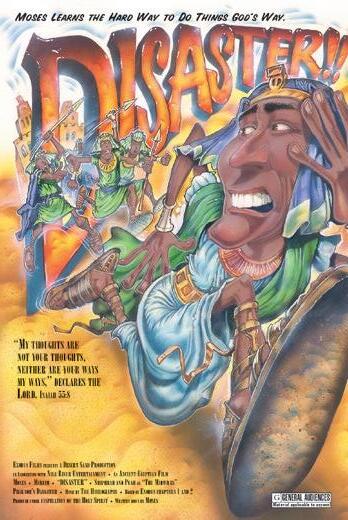
Objective: That your students will look for oportunities to follow God’s way this week.
Materials:
□ copies of “Pop Quiz!” Teaching Aid—used in Step 1
□ Bibles
□ pencils
□ markers
Moses was 40 years old when he killed the Egyptian. As we’ve learned, he definitely wasn’t following God’s way when he committed this crime. If he had trusted in God to give him guidance, he would not have killed the man. Even though you are not nearly as old as Moses, you are like Moses in one important way. You can make choices whether to follow God’s way or your own way.
We have choices every day. We can live the amazing, original, one-of-a kind life God has planned for us. This week there’s probably some situation in which you can choose your way or God’s way. Whether we want to admit it or not, when we face a choice, we are wisest when we remember that God wants us to do things His way.
As a class, brainstorm different choices and situations your preteens will face during the week. On the back of the quiz from Step 1, have each student write down several ideas of when they will ask for help in doing things God’s way next week (sitting with someone at lunch who appears lonely; doing a chore before being asked; sending someone a note to encourage or cheer them; walking away when tempted to fight with a sibling). Then have them creatively write the memory verse, Isaiah 55:8, under their ideas to remind them that God will help them follow His way.
Spend some time discussing their answers. End in prayer asking for God’s help to follow His way in the specific areas students mentioned.
Send home the Cover wrap of Bible Adventures. Point out how it is a movie poster of today’s lesson.
Close the session in prayer. Be aware of students who might wish to talk with you about salvation. You’ll find suggestions for discussing salvation on the inside back cover of this teacher’s commentary.
As you discuss salvation with your class, remember that each student is developmentally different. Some students may not be spiritually mature enough to go through all the steps to become a Christian or all the steps to have a relationship with God. They may not fully understand that they are accountable to God for their sins and need forgiveness that Christ makes possible.
However, learning that God loves them and wants to forgive their sins will prepare them for the time when they are ready to receive Christ as Savior. You and your church family have the responsibility to provide this information and the environment for this learning.
For those who do express an interest in personal salvation, try talking with them alone after class or arrange a time for them to meet on this subject with the pastor or one of the church officers. As you prepare to talk with a student about his/her personal salvation, you may want to read the Scriptures listed to reacquaint yourself with their messages. Share this information naturally with your student.
Help your students know how to pray. This should include teaching how to tell Jesus they believe He is God’s Son, they are sorry for their sins, and they want Him to forgive them and be with them always.
The two sets of steps listed here are a help for you to be ready to respond whenever the Holy Spirit leads a student to you to make a commitment to Christ. To give your student both steps at once may be too much to process. Offer steps to your student as you are led by the Holy Spirit.


1. Respond to God’s invitation to salvation Jeremiah 31:3; John 3:16
2. Seek a relationship with the Lord Isaiah 55:6-7; Matthew 6:31-33
3. Confess your sins Romans 3:23 and 10:9-10; 1 Corinthians 15:3-4; 1 John 1:9
4. Repent of your sins
2 Chronicles 7:14; Luke 13:3 and 15:7; Acts 17:30
5. Ask God to save you Romans 10:13
1. Listen to the Holy Spirit
John 14:26; John 16:13-14
2. Adjust your life to God’s will Jeremiah 18:1-6; Matthew 22:37-38; John 5:17, 19-20, and 8:47
3. Learn to be God’s servant Matthew 20:26-28; Philippians 2:5-8, 13
4. By faith, join God in His work Amos 3:7; Hebrews 11:24-29; James 5:17-18
5. Remain faithful to God Philippians 3:4-14



Every page of these bestselling Action Bible products sparks excitement in kids to explore God’s Word and know Him personally. THE ACTION BIBLE EXPANDED EDITION The Bestselling Illustrated Bible for Kids THE ACTION BIBLE FAITH IN ACTION The Bestselling Interactive Bible for Kids THE ACTION BIBLE HEROES AND VILLAINS
Purchase your copies at DavidCCook.org or wherever books are sold


Illustrated Facts of 75 Bible Characters THE ACTION BIBLE 52-WEEK DEVOTIONAL
A Year’s Worth of Devotionals and Activities for Kids
Upper Elementary Teacher’s Commentary No. 5050

How to get your Echoes
For best results, download PraisePAC resources to
Quarter’s Access Code: 242150519
*While it is possible to download a .ZIP compressed file to a mobile device, you may need to install a helper App first, like UnZip or WinZip. Check the Apple App Store (iOS) or the Google Play Store (Android) for a suitable app. Search for “Zip file opener.”
Designed for use with Upper Elementary Teacher’s Guide, Bible Adventures, and Pix
Lesson Teaching Aid
All Lessons PraisePAC—Audio files and Booklet
All Lessons Map—“Bible Map Figures”
All Lessons Time Line of the Bible—“God’s Master Plan of Salvation/God Sets His People Free”
1-9 Map—“The Long March Home”
1 Reproducible—“Pop Quiz!”
4 Poster—“Passover”
4 Reproducible—“Isaiah 43:1–7”
6 Reproducible Game Cards—“Roadblock”
8 3-D Model and Cards—“The Tabernacle”
10–13 Map—“Home at Last”
10 Poster—“Amazing Stories”
12 Activity Cards—“God’s 911”
13 Heroes of the Bible Poster—“Joshua”
ECHOES UPPER ELEMENTARY CREATIVE TEACHING AIDS is published quarterly by David C Cook, DavidCCook.org. © 2025 by David C Cook, 4050 Lee Vance Drive, Colorado Springs, CO 80918, U.S.A. Bible In Life and David C Cook and its related logos are registered trademarks of David C Cook. All rights reserved. ISBN 978-0-781-44611-2 #1505125. Printed in Gunpo-si, Gyeonggi-do, South Korea, February–April 2025. All Scripture quotations, unless otherwise indicated, are taken from the Holy Bible, New International Version®, NIV® Copyright © 1973, 1978, 1984, 2011 by Biblica, Inc.® Used by permission. All rights reserved worldwide.
Cover Photo: © Klaus Vedfelt/Getty Images

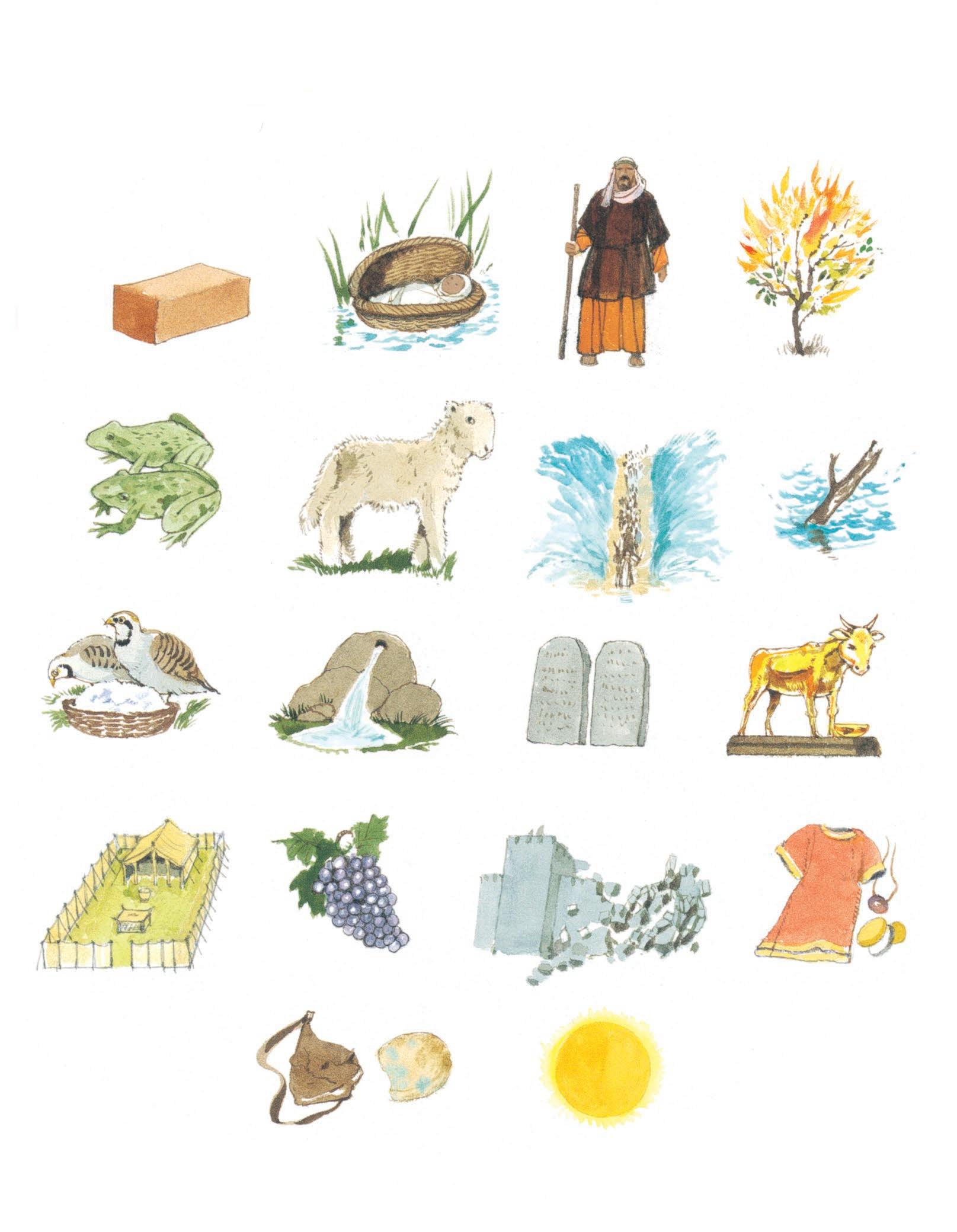
Use tape or a glue stick to add the figures to the maps.
Directions: Please do not speak or ask any questions while anyone is working on this quiz. Keep your eyes on your own papers. When you have finished, sit quietly until everyone has finished.
1. Read every instruction before you do anything.
2. Proceed carefully and cautiously.
3. Write your name in the space provided.
4. Draw a picture of your favorite barnyard animal.
5. Cover your mouth with your left hand if you are right-handed and with your right hand if you are left-handed.
6. Print the word “Bible” in the upper right-hand corner of this page.
7. Tug on your left earlobe.
8. Put the name “Moses” in the lower right-hand corner of this page.
9. Write down the name of your favorite food.
10. Nod your head “yes.”
11. On the reverse side of this page, write the names of any three books of the Bible.
12. Circle the book of the Bible that has the most letters in its name.
13. Draw a triangle around the circle you just drew.
14. Touch your forehead with your right index finger.
15. Snap the fingers of your left hand.
16. If you think you have followed these directions, write “I have” at the bottom of this page.
17. On the reverse side of this page, write the word “wink.”
18. Draw an eye shape around the word “wink,” and then add eyelashes.
19. Shut your eyes for three seconds.
20. Please ignore instructions four through nineteen. Follow the instructions in sentence three, and hand in your quiz.
Fall 2025


LESSON 1
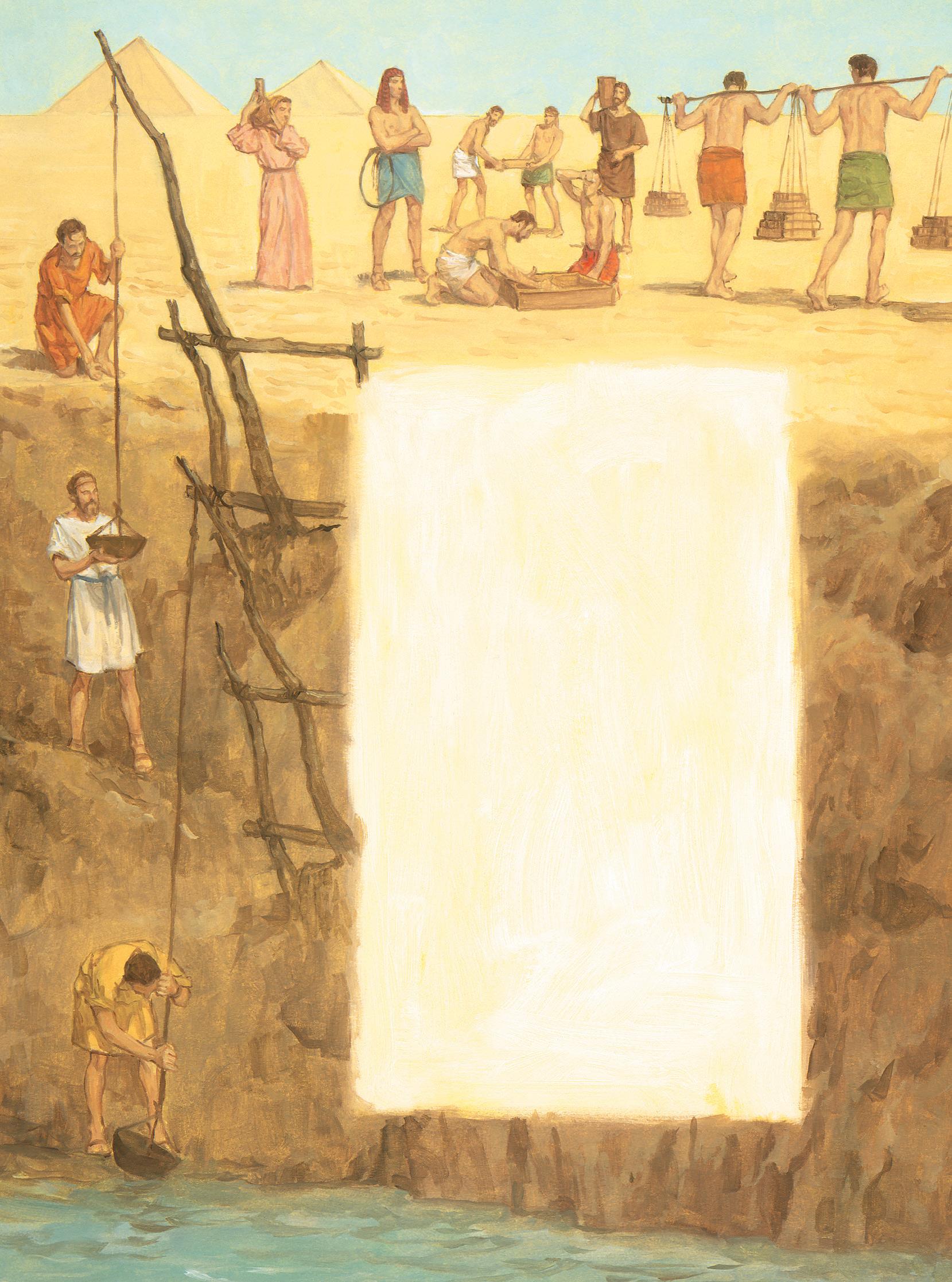
We know that African slaves lived an extremely hard life here in America. The lives of the Hebrew slaves were just as hard. One thing that helped the slaves in America while they waited for freedom was faith in God’s promises. The same thing—remembering God’s promises to their ancestors— helped make the Hebrews’ lives
more bearable while they worked and waited for their freedom from Egypt.
Finish each statement below by looking up the Bible verse and writing God’s promises in your own words. Then check off the statements that tell what God would have wanted the Hebrews to do while waiting for Him to keep His promises.
1. Genesis 15:13-15. When mistreated by their Egyptian slave masters, the Hebrews could remember God’s promise that after 400 years, He would:
2. Genesis 17:8. Even though the Hebrew captives could not own land in Egypt, they could remember that God had promised to:
3. Genesis 35:11. Even though the Egyptian king ruled over the Hebrews, they could remember that God had said:
Go on strike
Start a revolution
Teach their children God’s promises
Keep working
Worship God regularly
Complain to the overseer
Kill a few Egyptians each day
Have faith and keep praying
Daily talk about how hard things are
Hold weekly gripe sessions

1Egyptians called their kings pharaohs. Many people believed the pharaohs were gods.
Pharaoh1 decided to make slaves of the Hebrews. They had to work very hard making bricks to build Pharaoh’s cities. The slave drivers were mean and often beat them. But the Hebrew people kept growing in numbers.
Read Exodus 1:15-17. What did Pharaoh order the midwives2 to do? Why didn’t Shiphrah and Puah3 obey Pharaoh?
Exodus 1:22; 2:1-3, 11-14
2Midwives were like nurses. They helped mothers give birth to their babies.
3Pronounced SHIF-rah and PEW-ah.
Then Pharaoh gave this order to all his people: “Every Hebrew boy that is born you must throw into the Nile, but let every girl live.” Now a man of the tribe of Levi married a Levite woman, and she became pregnant and gave birth to a son. When she saw that he was a fine child, she hid him for three months. But when she could hide him no
longer, she got a papyrus basket for him and coated it with tar and pitch. Then she placed the child in it and put it among the reeds along the bank of the Nile.
Was it right for the midwives and the mother to disobey Pharaoh? Why?
One day, after Moses4 had grown up, he went out to where his own people were and watched them at their hard labor. He saw an Egyptian beating a Hebrew, one of his own people. Looking this way and that and seeing no one, he killed the Egyptian and hid him in the sand. The next day he went out and saw two Hebrews fighting. He asked the
4The name Moses sounds like the Hebrew words for “draw out,” referring to the way he’d been drawn out of the river.

one in the wrong, “Why are you hitting your fellow Hebrew?”
The man said, “Who made you ruler and judge over us? Are you thinking of killing me as you killed the Egyptian?” Then Moses was afraid and thought, “What I did must have become known.”
What did Moses do to the Egyptian who was beating the Hebrew? What did Moses do the next day? Who was Moses trusting in? Why?

When Pharaoh heard what Moses did, he tried to kill him. Moses had to run away to Midian.5
5Pronounced MID-ee-un. The country was named after Midian, a son born to Abraham and his new wife after Sarah died.
God tells us in His Word that our way of doing things is not necessarily His way. With that in mind, write out three possible options for handling the statements below. One might be your natural reaction, one might be a practical idea, and one might be God’s way of doing things. Use the Scripture below to help you write out God’s advice.

KEY VERSE
“My thoughts are not your thoughts, neither are your ways my ways,” declares the Lord Isaiah 55:8
1. Another kid messes up your gym shoes. You would:
Look at Colossians 3:13.
2. Your neighbor won’t let you play ball in the empty lot between your houses. You would:
Look at Romans 12:18.


3. During an overnight stay at a friend’s house, your friend begins to make phone calls to people she doesn’t know, just for fun. You would:
Look at Ephesians 5:4.

LESSON 7
LESSON 1
“My thoughts are not your thoughts, neither are your ways my ways,” declares the Lord. Isaiah 55:8


LESSON 2
[The Lord said,] “I will help you speak and will teach you what to say.” Exodus 4:12
LESSON 3
Blessed is the one who perseveres under trial. James 1:12


LESSON 4
“God is not human, that he should lie, not a human being, that he should change his mind. Does he speak and then not act? Does he promise and not fulfill?” Numbers 23:19
“Worship the Lord your God and serve him only.” Luke 4:8

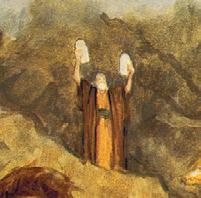
LESSON 8
“Christ may dwell in your hearts through faith.” Ephesians 3:17
LESSON 9
“Choose for yourselves this day whom you will serve.” Joshua 24:15


“Be strong and courageous. Do not be afraid; do not be discouraged, for the Lord your God will be with you wherever you go.” Joshua 1:9 LESSON 10
LESSON 11
“God is faithful; he will not let you be tempted beyond what you can bear. But when you are tempted, he will also provide a way out so that you can endure it.” 1 Corinthians 10:13

LESSON 5
“Now faith is confidence in what we hope for and assurance about what we do not see.” Hebrews 11:1


LESSON 6
“Those who are wayward in spirit will gain understanding; those who complain will accept instruction.” Isaiah 29:24

LESSON 12
“Blessed are those who keep his statutes and seek him with all their heart.” Psalm 119:2
LESSON 13
“With God all things are possible.” Matthew 19:26

ECHOES UPPER ELEMENTARY BIBLE ADVENTURES is published quarterly by David C Cook, DavidCCook.org. © 2025 by David C Cook, 4050 Lee Vance Drive, Colorado Springs, CO 80918, U.S.A.Echoes and David C Cook and its related logos are registered trademarks of David C Cook. All rights reserved. ISBN 978-0-78144786-7 #1505225. Printed in Gunpo-si, Gyeonggi-do, South Korea, February–April 2025. All Scripture quotations, unless otherwise indicated, are taken from the Holy Bible, New International Version®, NIV® Copyright © 1973, 1978, 1984, 2011 by Biblica, Inc.® Used by permission. All rights reserved worldwide. Bible Illustrations: Richard Williams; Footnote Art: Joe Van Severen; Footnote Maps: Jeff Carnehl; Cover 1 Photo: © Klaus Vedfelt/Getty Images; Cover 4 Art: Linda Giampa. Other Illustrations: Chuck Asay-Les. 8, p. 1; Les. 8, pp. 1,4; Paul Turnbaugh—Les. 1, p. 4; Les. 13, p. 4; Paul Buddle—Les. 6, p. 1; Bill Duca—Les. 10, p. 4; Les. 11, p. 4; Les. 12, p. 1; Les. 13, p. 1; Jim Engel—Les. 2, p. 1; Les. 9, p. 4; Tony Griego—Les. 5, p. 4; Les. 9, p. 1; Melanie Lawson—Les. 12, p. 4; Catherine Leary—Les. 3, p. 1; Ed Sobieraj— Les. 4, p. 4; Les. 7, p. 1; Michael Streff—Les. 7, p. 4; Bakstad Photographics, Les. 2, p. 4; Les. 8, p. 1; Darryl Martin/Gené Photography—Les. 1, p. 1; Norhill Photography—Les. 10, p. 1; Object photos © James Burnett/Captured Images; Sheep illustrations: Sandy Flewelling
based on exodus 1:1–2:10

The next day, Jochebed prepares a little basket.
Keep watch, Miriam, I’m almost finished.
Then, carefully avoiding the egyptian soldiers, she takes the basket and her tiny son to the river.
his basket will float like a little boat!
keep watch over him, miriam. oh my son, it tears my heart to send you away. may god watch over you and protect you.
Miriam hides in the bulrushes and watches ...
The princess! will she see the baby’s basket?
Look— what a strange little basket! I wonder what’s inside it.
thE MaiD bRingS THe BAsKEt TO the PriNCESs, wHo OpenS iT.
thE MaiD bRingS THe BAsKEt TO the PriNCESs, wHo OpenS iT.

a hebrEW BAby! listen To Him CRY! wE haVe tO FiNd SoMEOne To fEeD ANd carE FOR Him.
a hebrEW BAby! listen To Him CRY! wE haVe tO FiNd SoMEOne To fEeD ANd carE FOR Him.
jUST then, MiRiAm sTEPS Out of THe BUshES.
sHAlL I FiNd a hebREw nurSe fOR tHE BAbY?
sHAlL I FiNd a hebREw nurSe fOR tHE BAbY?
yEs. BRinG one To ME aS sOoN AS YOU can.
yEs. BRinG one To ME aS sOoN AS YOU can.
jUST then, MiRiAm sTEPS Out of THe BUshES. at ThE River’s EDGe…
at ThE River’s EDGe…
mothEr!
COMe RiGHT AwaY. thE PriNcesS HAs found OUR baBy — AND ShE WanTs A HebrEw NuRSe to TaKE CAre OF him.
mothEr! COMe RiGHT AwaY. thE PriNcesS HAs found OUR baBy — AND ShE WanTs A HebrEw NuRSe to TaKE CAre OF him.
gOd has AnSWerED mY pRayer, MiRiAm. MY soN wilL BE Safe WiTH thE PrincesS.
gOd has AnSWerED mY pRayer, MiRiAm. MY soN wilL BE Safe WiTH thE PrincesS.
tAke THiS baBy ANd carE FoR him. if AnYONe qUEstionS yOu, seND Word TO ME at onCe.
tAke THiS baBy ANd carE FoR him. if AnYONe qUEstionS yOu, seND Word TO ME at onCe. I’m naming him moses, because i pu ed him out of the water.
I’m naming him moses, because i pu ed him out of the water.
based on exodus 2; acts 7:22-29
So the hebrew baby is returned to his own home—but now under the protection of the king’s daughter. That night, amram and jochebed gather moses with his sister, miriam, and brother, aaron. They kneel and pray.
young moses lives in his home until he is about four years old. then his mother takes him to the palace to live with the princess, who adopts him.

o God, we thank you for saving our little son. help us to train him to serve you.
years pass, and the boy moses lives the life of a young prince in pharaoh’s palace. one day he drives through the city ...
... To a place where hebrew slaves are working. as he watches the slaves toil, he is startled by a man’s scream ...
moses jumps from his chariot to investigate—and finds an egyptian guard beating a hebrew slave.

i n sudden anger, moses strikes out hard ...
Look! he killed the guard!
The next day Moses returns. When he s s two Hebrews fighting, he tries to stop them.
People know I have ki ed a man. There’s only one thing I can do, and I have to do it now! Don’t fight each other!
Who made you a judge over us? Are you going to ki me the way you ki ed that Egyptian?

Later that day in the palace…
Prince Moses ki ed an Egyptian guard for beating a Hebrew slave.
But Pharaoh’s orders come t late. Moses has a head start on the soldiers who chase him. He escapes— and after a long, hard ride, he reaches the land of Midian.
Tired after his flight from Pharaoh, Moses rests by a we .

Get away from here until we water our sh p!
No! We were here first. You leave us alone!
I think you should let the women go first. After a , that’s the civilized thing to do.
When the women return to their camp, one of them te s her father what ha ened at the we .
A man saved you and you came straight home? Why didn’t any of you ask him to di er?
I am Zi orah. My father, Jethro, invites you to eat with us.
Moses a epts the invitation, and that night after su er…
I n d a shepherd — a g d man I can trust. Why don’t you stay with us?
Thank you, I wi .
This wi be a g d place to hide from Pharaoh.

Rally everyone in your family to read this lesson together.
Pause a minute Play
1. You all planned to sleep in Saturday and enjoy a leisurely breakfast together. Finally, no morning commitments. But at 7:15 the doorbell rings and rings. Your older neighbor’s dog is loose and the man can’t run after him. He’s begging for help. So much for being in control of your weekend. Read about being in control in Isaiah 55:8.
Take a look back
3.Why is it tempting to do things you want more than what you know is best? What happens when you let go of your wants and help others? How can your thoughts better line up with God’s?
“My thoughts are not your thoughts, neither are your ways my ways,” declares the LORD.
Isaiah 55:8
Record your thoughts

2. Moses took being in control to an extreme in doing things his way. He killed a mean Egyptian. Moses then tried to bury his mistake. Moses’ acting on impulse cost a life and he lost his homeland. On strips of paper, each of you write down a couple mistakes you’ve made in going your own way. Bury the strips in your garden or in a pot of soil. Talk about what Isaiah 55:8 says and how you can encourage each other to live life God’s way. Throw away the strips of paper with the mistakes written on them.
4.Put the main TV remote control on the family room floor. Count to three and all grab for it (without hurting someone). What mayhem! Grasping for control isn’t pretty. Pray together to follow God’s ways during the week.
Read more this week about Moses trying to do right in his own way: □ Exodus 1:7-22 □ Exodus 2:1-10 □ Exodus 2:11-15